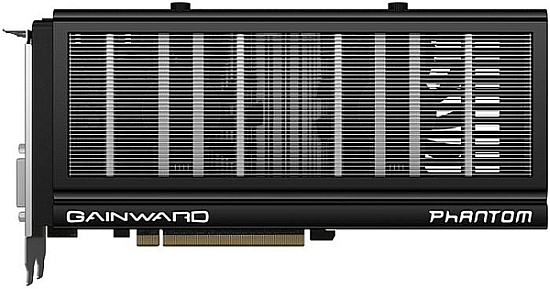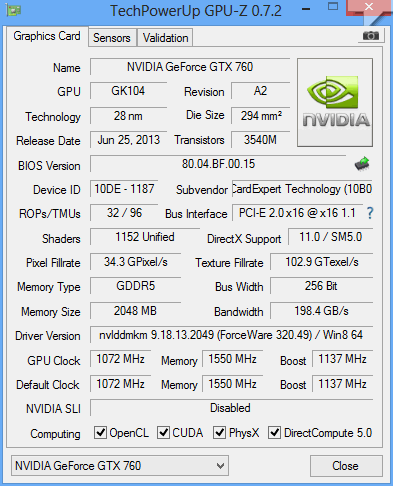Index


Review: Silence and Sweet-Spot price/performance
Today we’ll take a closer look at the recently introduced Gainward GTX 760 2GB with the Phantom cooler. The GTX 760 Phantom is a factory overclocked card, with bumped up GPU and memory frequencies, yet thanks to the Phantom cooler it is supposed to be quite a bit quieter than the reference card.

Note that the cooler is three slots wide and as such it may not be compatible with small or cramped cases. However it is good to know that Gainward’s portfolio includes other GTX 760 graphics cards based on the reference design, with the dual-slot cooler and blower style fan.

The GTX 760 was designed with gamers on a budget in mind. It is supposed outpace the old GTX 660 Ti and it is basically its direct replacement. The Phantom’s GPU is clocked at 1072MHz, or 92MHz over the reference cock. The Boost clock is 1137MHz, while the reference card boost clock is 1033MHz. Gainward also bumped the GDDR5 clock from 1502MHz to 1550MH, effectively 6200MHz. It is worth noting that cards with overclocked memory are becoming somewhat of a rarity these days. Most AIBs are choosing to overclock the GPU and not tinker with the memory. However, in many scenarios GPU overclocking does not offer good results if the memory clock is not upped as well.

At the heart of the GeForce GTX 760 lies the same GK104 GPU that is used in the GeForce GTX 770, but remember that the GK104 GPU is used on GTX 690/680/670/660Ti cards as well.
The GTX 760 has 1152 CUDA cores, while the GTX 660 Ti boasts 1334. The GTX 760 ended up about 6-8 percent faster than the GTX 660 Ti, but where is all that new-found speed actually coming from? It is safe to assume that the extra performance comes from higher clocks. The GTX 760 is stock clocked at 980MHz, while the Boost clock is 1033MHz, whereas the GTX 660 Ti is clocked at 915MHz and the Boost clock is 980MHz.
The bandwidth is somewhat higher as well, as the GTX 660 Ti features a 192-bit memory bus, while the GTX 760 has a 256-bit bus. On the whole the GTX 760 seems to be designed for 1080p gaming on a budget, and it is also direct threat to the ageing GTX 670.
The standard memory configuration for the GTX 760 is 2GB of GDDR5 memory, but some Nvidia partners offer 4GB cards as well. The GTX 760 has a 170W TDP, compared to 150W TDP for the GTX 660 Ti and 170W TDP for the GTX 670.
Following the introduction of the GTX 760, Nvidia’s complete Geforce 7xx/6xx lineup consists of the following cards:
Geforce GTX TITAN (GK110)
GeForce GTX 780 (GK110)
Geforce GTX 690 (2xGK104)
Geforce GTX 770 (GK104) Geforce GTX 680 (GK104)
Geforce GTX 670 (GK104)
Geforce GTX 760 (GK104) Geforce GTX 660 Ti (GK104)
Geforce GTX 660 (GK106)
Geforce GTX 650 Ti BOOST (GK106)
Geforce GTX 650 Ti (GK106)
Geforce GTX 650 (GK107)
Geforce GT 640 (GK107)
Geforce GT 630 (re-branded Geforce GT 440)
Geforce GT 620
